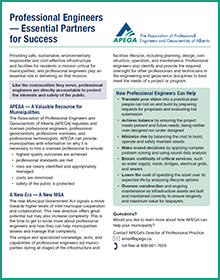Professional Engineers — Essential Partners for Success
Providing safe, sustainable, environmentally responsible and cost-effective infrastructure and facilities for residents is mission critical for municipalities, and professional engineers play an essential role in delivering on that mission.
Like the communities they serve, professional engineers are directly accountable to protect the interests and safety of the public.
APEGA — A Valuable Resource for Municipalities
The Association of Professional Engineers and Geoscientists of Alberta (APEGA) regulates and licenses professional engineers, professional geoscientists, and professional licensees. APEGA can provide municipalities with information on why it is necessary to hire a licensed professional to ensure:
- highest quality outcomes are achieved
- professional standards are met
- risks are clearly identified and appropriately managed
- costs are minimized
- safety of the public is protected
A New Era — A New MGA
The new Municipal Government Act signals a move towards higher levels of inter-municipal cooperation and collaboration. This new direction offers great potential but may also increase complexity. This is the time to get to know more about professional engineers and how they can help municipalities assess and manage that complexity.
The unique and specialized knowledge, skills, and capabilities of professional engineers aid municipalities during all stages of the infrastructure and facilities lifecycle, including planning, design, construction, operation, and maintenance. Professional engineers also identify and provide the required oversight for other professionals and technicians in the engineering discipline to best meet the needs of a project or program.
How Professional Engineers Can Help
- Translate your vision into a practical plan people can bid on and build by preparing requests for proposals and evaluating bid submission
- Achieve balance by ensuring the project meets present and future needs, being neither over designed nor under designed
- Minimize risk by balancing the cost to build, operate and safely maintain assets
- Make sound decisions by applying complex problem solving and using sound data analysis
- Ensure continuity of critical services, such as water supply, roads, bridges, electrical grids, and sewers
- Lower the cost of operating the asset over its expected life by analyzing lifecycle options
- Oversee construction and ongoing maintenance so infrastructure assets are built and maintained correctly to ensure longevity and maximum value for taxpayers

